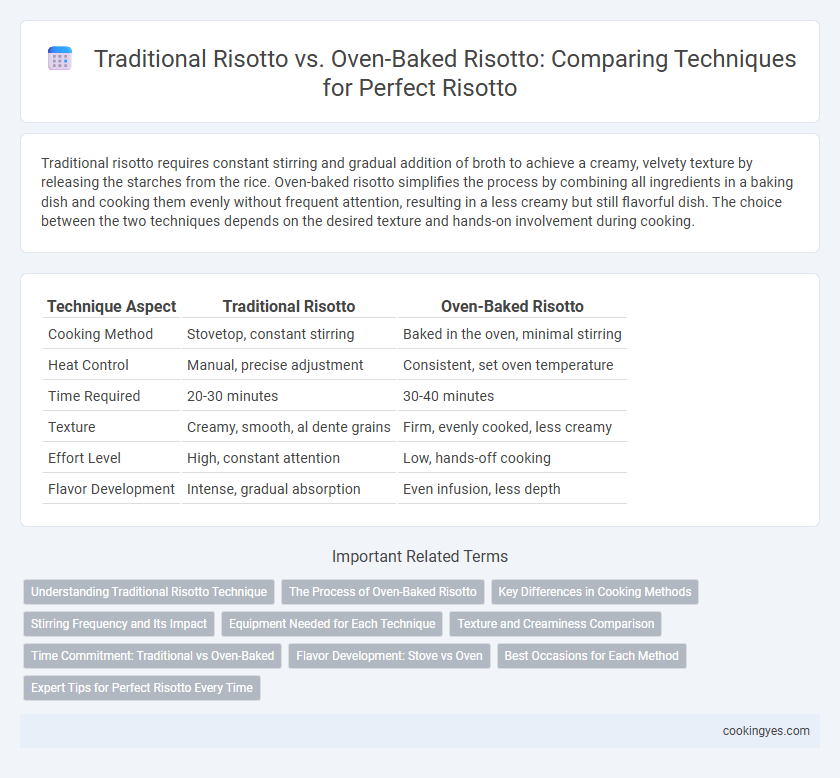Traditional risotto requires constant stirring and gradual addition of broth to achieve a creamy, velvety texture by releasing the starches from the rice. Oven-baked risotto simplifies the process by combining all ingredients in a baking dish and cooking them evenly without frequent attention, resulting in a less creamy but still flavorful dish. The choice between the two techniques depends on the desired texture and hands-on involvement during cooking.
Table of Comparison
| Technique Aspect | Traditional Risotto | Oven-Baked Risotto |
|---|---|---|
| Cooking Method | Stovetop, constant stirring | Baked in the oven, minimal stirring |
| Heat Control | Manual, precise adjustment | Consistent, set oven temperature |
| Time Required | 20-30 minutes | 30-40 minutes |
| Texture | Creamy, smooth, al dente grains | Firm, evenly cooked, less creamy |
| Effort Level | High, constant attention | Low, hands-off cooking |
| Flavor Development | Intense, gradual absorption | Even infusion, less depth |
Understanding Traditional Risotto Technique
Traditional risotto technique emphasizes constant stirring and gradual broth incorporation to achieve a creamy texture and perfectly al dente rice. This method requires careful attention to release starch from Arborio or Carnaroli rice varieties, which is crucial for the dish's characteristic richness. In contrast, oven-baked risotto simplifies cooking by combining ingredients and baking, but it lacks the depth of flavor and texture control offered by the traditional stovetop approach.
The Process of Oven-Baked Risotto
Oven-baked risotto streamlines the cooking process by combining rice, broth, and aromatics in a single baking dish, allowing even heat distribution and hands-off cooking compared to the continual stirring required in traditional risotto. This method preserves the creamy texture characteristic of risotto while reducing the risk of scorching or uneven cooking. The oven-baked technique emphasizes simplicity and convenience without sacrificing the dish's rich, velvety consistency.
Key Differences in Cooking Methods
Traditional risotto requires constant stirring and gradual addition of hot broth to release the starches from Arborio rice, creating a creamy texture. Oven-baked risotto involves combining ingredients in a baking dish and cooking without stirring, yielding a firmer, less creamy consistency with a crusty top. The key difference lies in the stove-top method's active attention versus the oven method's passive, even heat exposure.
Stirring Frequency and Its Impact
Traditional risotto requires constant stirring to release the starch from Arborio rice, creating a creamy texture, while oven-baked risotto involves minimal stirring due to its slow, even cooking environment. Frequent stirring in the traditional method promotes gradual liquid absorption and prevents sticking, resulting in a tender yet cohesive dish. Oven-baked risotto's reduced stirring leads to a slightly firmer texture with distinct rice grains due to less mechanical starch release.
Equipment Needed for Each Technique
Traditional risotto requires a stovetop, a heavy-bottomed pan such as a wide saucepan or skillet, and a wooden spoon for continuous stirring. Oven-baked risotto simplifies the process by utilizing an oven-safe baking dish and aluminum foil or a lid, eliminating the need for constant monitoring and stirring. The stovetop method demands more active attention and specific cookware, while oven-baked risotto relies on passive cooking with minimal equipment.
Texture and Creaminess Comparison
Traditional risotto requires constant stirring and gradual addition of broth to release starches, resulting in a creamy, luscious texture with al dente rice grains. Oven-baked risotto simplifies the process by slow-cooking with liquid in a covered dish, producing a firmer, less creamy consistency with slightly drier rice. The contrast in technique directly influences the final texture: traditional risotto achieves a smoother, more velvety finish, while oven-baked risotto offers a heartier, more textured bite.
Time Commitment: Traditional vs Oven-Baked
Traditional risotto requires constant stirring over low heat for 18-20 minutes, ensuring gradual absorption of broth and creamy texture. Oven-baked risotto reduces hands-on time by combining ingredients in a casserole and baking for 30-40 minutes, allowing unattended cooking with less stirring. While traditional risotto demands more active involvement, oven-baked risotto offers convenience without significantly compromising flavor or consistency.
Flavor Development: Stove vs Oven
Traditional risotto prepared on the stove allows for continuous stirring, which helps to release the starch from the rice, creating a creamy texture and deep, rich flavor. Oven-baked risotto requires less attention during cooking and emphasizes even heat distribution but may produce a slightly less creamy and less intense flavor compared to the stovetop method. Flavor complexity in stove-cooked risotto benefits from gradual liquid absorption and caramelization, while oven-baked risotto offers convenience with a subtler taste profile.
Best Occasions for Each Method
Traditional risotto, cooked slowly on the stovetop, is ideal for intimate dinners or occasions where precise control over texture and creaminess is desired, such as family gatherings or fine dining experiences. Oven-baked risotto suits busy settings or large groups, providing a hands-off method that allows uniform cooking without constant stirring, perfect for casual parties or buffet-style meals. Choosing between these techniques depends on the event's formality, time constraints, and desired consistency of the risotto.
Expert Tips for Perfect Risotto Every Time
Traditional risotto requires constant stirring and gradual addition of hot broth to achieve a creamy, al dente texture, while oven-baked risotto simplifies the process by combining ingredients and baking slowly for even cooking. Expert tips emphasize using high-starch Arborio rice, maintaining consistent heat, and incorporating flavorful broth for depth. For perfect risotto every time, mastering the traditional technique ensures precision, whereas oven-baked methods offer convenience without sacrificing texture.
Traditional risotto vs oven-baked risotto for technique Infographic

 cookingyes.com
cookingyes.com